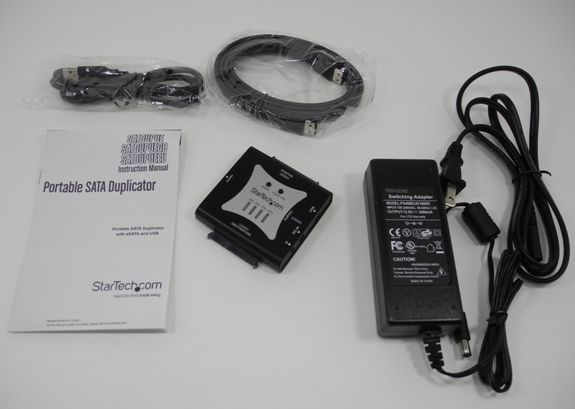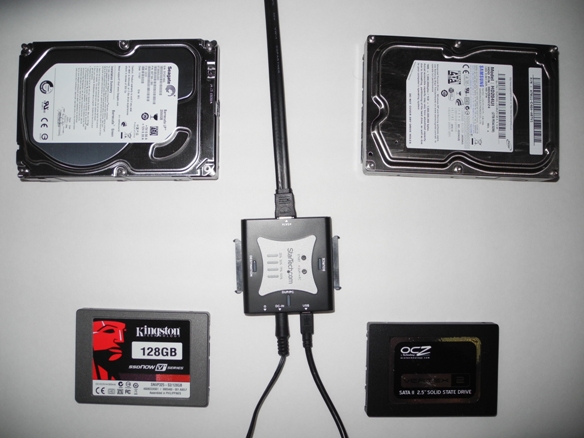StarTech.com Portable SATA Duplicator & USB / eSATA Dock Review
by Ganesh T S on September 6, 2011 6:50 PM EST- Posted in
- Gadgets
The SATDUPUE package contained the following:
- Portable SATA duplicator / dock
- 36W power adapter
- eSATA - eSATA cable
- USB 2.0 A Male to Mini-B 5 pin Male cable
- Instruction manual
Before getting into the test setup and benchmarking process, it is important to understand the usage and limitations of the product.
In the dock mode (default, green mode status LED), connecting two drives will result in a JBOD configuration (2 distinct disks visible to the PC). However, this is only through the USB port. If seen through the eSATA port, only the drive connected to the destination is seen (unless the PC's eSATA port supports port multipliers). When both USB and eSATA are connected, USB takes preference.
The product can be put into the duplicator mode (red mode status LED) by keeping the mode button pressed for 3 seconds. In this mode, the drive connected to the destination must be of equal or higher capacity compared to the drive connected to the source port. In our testing, we made sure that there was no EISA partition in the source drives. StarTech.com specifically mentions that the EISA partition must be removed prior to duplication.
Our test setup consisted of the following:
- SATDUPUE
- Seagate Barracuda LP 2000 GB 3.5" Hard Drive [ ST2000DL003 5900 rpm 64MB ]
- Samsung EcoGreen 2 TB 3.5" Hard Drive [ HD204UI 5400 rpm 32 MB ]
- OCZ Vertex 2 OCZSSD2-2VTX120G 2.5" 120GB SSD
- Kingston SSDNow V+ Series SNVP325-S2/128GB 2.5" 128GB SSD
For testing the dock functionality, the OCZ Vertex 2 drive was hooked up to a 6 Gbps SATA port in the ASRock CoreHT 252B's HM65 based motherboard as a secondary drive. The eSATA port in the CoreHT 252B unfortunately doesn't support the port multiplier function.
Two sets of tests were performed, one in DOCK mode and the other in DUPLICATOR mode. All the tests involved transfer of the HQV 2.0 Benchmark Blu-ray folder backup (11.37 GB Blu-ray folder structure) using the robocopy command in mirror mode. While the stress was on transfer rate measurements, the duplicator mode also offered interesting insights into the power consumption and temperature factors.
In the next section, we will look at the benchmark results and present our conclusions.


















36 Comments
View All Comments
Nickel020 - Wednesday, September 7, 2011 - link
I didn't know such a product exists, and I'm now considering getting one. I like it that AT now occasionally does short reviews like this. As long as the lon reviews keep coming, more is better.To omit information because the reader may assume it is a terrible practice. I always like reviews that are very detailed - if they're well structured, they can still be enjoyable to read. I should not need to go to the manufacturer's homepage for further info after reading a product review.
"A summary paragraph is much more professional. "
You're not being serious, are you? The purpose of a review is to present original and available information in an understandable way and help make a purchasing decision (not look "professional" and only understandable for elitist users). Pro/Con lists help a lot there from a didactic standpoint. I wish AT would use them more, like JonnyGuru does for example. They make information considerably easier to grasp than a wall of text.
It's also called a summary for a reason. It's meant to readable stand-alone. Hence the name. Hence the need to re-state information.
lpjz290 - Wednesday, September 7, 2011 - link
Reikon, you're talking through your hoop! The purpose of the articles on this well-respected site is to help us make informed buying decisions, not to present to the IEEE or some other research organizations as research papers and the likes!In order to keep readers informed,there is a need to repeat what features the products have and what they can do. Otherwise, what's the point of even doing a review?
The use of bullets is very useful to reinforce what the product is supposed to be good at, or whether the product is worth considering. And if you don't know, bullets do a better job at helping readers digest the huge amounts of information. nobody will want to re-read an entire page of text just to recap!
If you want to be so elitist and make everything as you perceive to be "professional", please leave this site and start your own.
Reikon - Wednesday, September 7, 2011 - link
*sigh* Okay, I might have been a bit harsh to say the article itself was bad. It's just there's way too much useless and redundant information that makes the article SEEM like it's from a site that has nothing to really say.I still stand by the pro/con list specifically in this review is almost pointless. The vast majority of the info is obvious (function, size) or is in an easy to read table just a little bit above the pro/con list. He could have easily turned it into a several sentence summary that's still very easy to read, but instead it looks like a padded list to create "content."
sleepeeg3 - Wednesday, September 7, 2011 - link
It's an adapter. How much is there really to say? Sheesh.colmiak - Wednesday, September 7, 2011 - link
agreed. quality review just like all anandtech articles.this a small product with not much to say and the cons/pros list is great way to summarize a short article. i mean... theres not much more to say :)
dhuhtala - Tuesday, September 6, 2011 - link
The most important thing to me is to be able to manage the size of the partitions - I'm almost always replacing a hard drive with a larger capacity drive. There's no mention here as to whether or not this device supports increasing the size of the target volume. I'm assuming it won't...which makes the device completely useless to me...ganeshts - Tuesday, September 6, 2011 - link
Volume management needs to be done on the PC.For example, when I cloned the SSD to the HDD, all the partitions on the SSD got reflected onto the HDD, but the remaining ~1.7 TB of space on the HDD showed up as unallocated in the Windows Disk Management console. I was able to make this into a separate partition without affecting the cloned data.
rustycurse - Wednesday, September 7, 2011 - link
quotes: "However, waiting for more than 5 hours to get a 2 TB drive cloned' & "Product gets quite hot to touch and needs proper heat dissipation when operating" ......at least ...you can boil (warm) your cup of coffee (tea).....;)
Take care...;)
P.S. Anyway... thanks to all Anandtech team for keeping us informed
c4v3man - Wednesday, September 7, 2011 - link
Unless the device is certified as blocking all writes, and making no changes whatsoever to the source disk, then this device will simply DESTROY evidence, not duplicate it. There's a reason why Tableau and other manufacturers can charge $200+ for devices that do less... It's because they are certified, serial-numbered devices that preserve the integrity of the evidence in a repeatable verifiable manner, and are reliable products that get the job done.Now for 99.9% of our tasks at our shop, we use similar devices to this Startech unit, and they work very well. Most people don't need to forensically duplicate a hard drive, so this is a good/great product. The article, however, shouldn't claim a use that it's not capable of performing.
Spoooon - Wednesday, September 7, 2011 - link
I interpreted it as a list of possible uses for this type of device, not uses specific to this brand and model device.